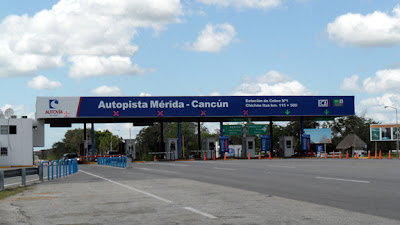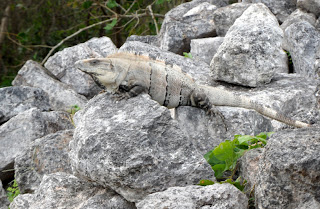Ek’ Balam
Leaving Merida by car or bus, after circling the outskirts of the city on the Periferico, my hosts, Evonne and Sam headed for the super highway that takes one to Cancun. After about 50 miles or so, one encounters a large, very modern toll booth.
Located about half way between Cancun and Merida, north of
Valladolid, lies the relatively newly excavated (mid 1990’s) archeological site
of Ek’ Balam, or the “Black Tiger”. Since it was neither huge in size, nor overly
touristed, it was a delight to visit. Its
“claim to fame” among Mayan sites is its remarkably well-preserved stucco
frieze, which had been protected by a 2-foot thick stone façade near the top of
the site’s main pyramid. This Pyramid,
known as the Acropolis, is still open
to be climbed, unlike the more famous Chichen Itza and others.
Although not as elegant or commanding as Chichen
Itza’s Temple of Kukulkan, the Winged
Serpent, it is taller, rising to 108’ in height. The steps still show fossils of shells,
suggesting that either they were excavated from lands closer to the sea, only
about 70km to the north where the flamingos live in Rio Lagartos, or that the entire pancake-flat area was underwater
long ago. Some geologists postulate that
the Yucatan, Cuba and Florida were all one land mass at one time.
Ek’ Balam was probably
founded around 300 BC., reaching its height between 700-1100 AD. Although it is a walled city, the wall is low
and wide, so it probably had nothing to do with defense, as is so clearly the
case at Tulum. It is speculated that it probably served a
more social function … of separating the gentry from the peasants, who may have
been forbidden entry except for specific purposes. If so, it may have been one of the first “gated
communities” for the elite.
El Trono, or “The
Throne”, was the name given to the stucco frieze of carvings 2/3rds of the way
up the Acropolis, which are centered
around an open Jaguar Mouth, complete with teeth. Several of the statues, notably the one that
sits atop the main door, are now headless, whether due to erosion or “beheading”
is mere speculation. But the fact that the
carved frieze was sealed behind a wall soon after completion suggests to me
that perhaps it was built by a leader/king, who was then dishonored or
conquered and his “life’s work” was desecrated by his enemy and/or successor, the
conquered one’s representations losing their heads, while priests in the frieze
remained in possession of theirs. Some
of the priests have wings, like angels, a rather unique representation among
Mayan sites, while others are deformed, often considered a sign of spirituality
to the Maya.
Possessing a north and south plaza with a ball court in the
middle, Ek’ Balam was probably an important commercial center in its day.
The South Plaza is dominated by an Oval
Palace, known as La Redondo for its rare rounded wall.
To its left, built in the more standard
rectangular fashion, are two attached, once-identical buildings know as Las Gemelas, the twins.
Like most Mayan ruin sites, the current inhabitants are mostly birds and lizards. Here is a proud iguana posturing amid the ruins.
There is a near-by Cenote
X’Canche, which has become the center of a community-run ecotourism project
that I did not get to visit. Instead we
went to the close-by Italian Restaurant and B&B known as Dolcemente for an early dinner. So far the Italian pastas I have ordered in
and around Merida have all been on the somewhat “crunchy” side, or to my way of
thinking, barely cooked. But dinner was tasty
and dessert was fabulous! And the kids in the village were friendly...











No comments:
Post a Comment